Oden is a Warming and Nourishing Japanese Hot Pot

As soon as the weather starts to cool in Japan during autumn, steaming baths filled with mysterious-looking products appear at the counter of convenience stores. This dish is known as “oden”, and is a type of a nabemono (hot pot), made of various ingredients cooked in a broth of dashi, soy sauce, sake and mirin. It’s popular as an accompaniment to alcohol, and although most commonly eaten as a warming comfort food in cooler months, oden can also be found in summer as hiyashi oden, which is served chilled. The condiments commonly served with oden include karashi, Japanese mustard, and yuzu citrus paste.
What is Oden?
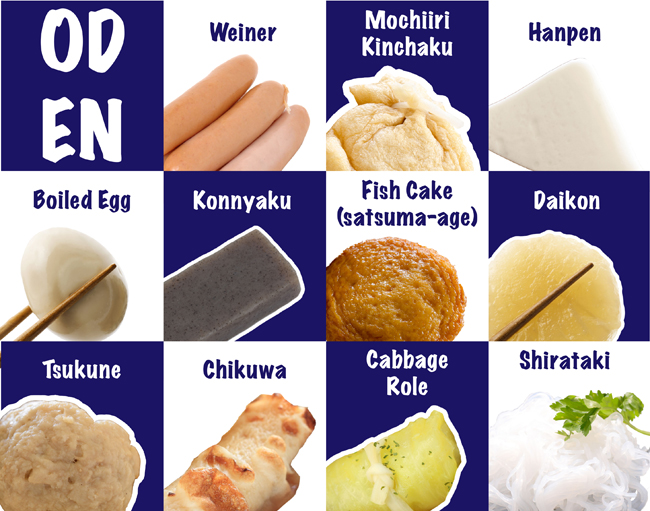
It’s thought that oden has been around since the Muromachi period (1336–1573), with its origins in konnyaku dengaku—skewered konnyaku (a kind of potato, made into flour and mixed with a solution of water and calcium) served with miso paste. The ‘den’ kanji used in dengaku is also used for oden, with the honorific prefix ‘o’ added.
Where to Eat Oden
Aside from being sold at convenience stores, oden features on izakaya menus, is sold at festivals and events, in specialty oden stores, and can even be found in cans from vending machines. During the Edo period, carts selling oden and warm sake called “Oden Kanzake” were a common sight at train stations during winter, and were a popular and quick meal for salaryman on their way home from work. With the prevalence of convenience stores, the number of such carts have declined in recent years. Oden can also be easily made in the home, either by buying ingredients individually or in pre-made packages.
Regional Varieties

Of course, to truly answer the question, “What is Oden?”, you should also take regional variations into account. The most clear distinction exists between Kanto style of eastern Japan and the Kansai style of western Japan. Kanto style has a darker color and stronger broth, made with koikuchi (dark) soy sauce. Kansai style has a lighter color, slightly sweeter broth with a stronger kombu flavor, and is made with usukuchi (light) soy sauce. Nagoya oden features a version using a hatcho miso-flavored broth and served with a soy dipping sauce. Shizuoka oden has a dark broth colored with black hanpen (fishcake) produced in Yaizu, with all ingredients skewered and served with aonori (powdered dried seaweed) and katsuoboshi (bonito fish flakes). Nagano region uses a leek sauce, and in Okinawa the oden features pig feet (techibi) and seasonal vegetables.
Oden Ingredients
While there’s a range of other oden ingredients that can be included in addition to the ones below—beef tendon, octopus, potato, carrot, mushrooms and more—here are some of the most popular.
Daikon

Daikon is a variety of radish popular in Japan. It’s a long white root vegetable that can be eaten raw or cooked in a variety of dishes. When eaten raw is crunchy and a little spicy, but when it’s braised for a long time in dashi, it becomes very soft and a little sweet, and absorbs the flavor of the cooking liquid and turns a golden color. For oden, the daikon is peeled and the cut into thick discs.
Chikuwa
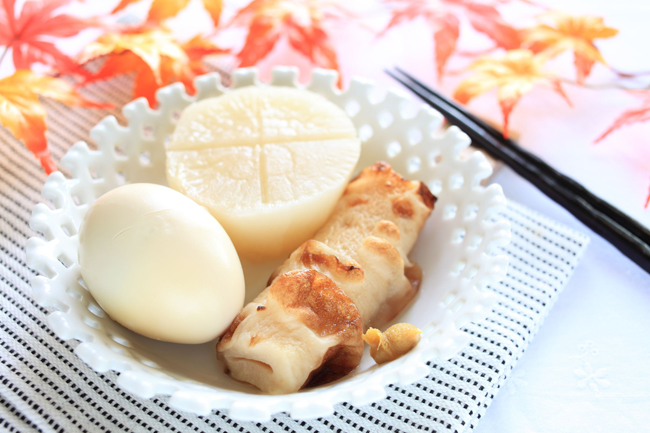
To make chikuwa, fish surimi, salt, sugar, egg white and cornstarch is mixed together to form a paste. This paste is then shaped into a log and wrapped around a stick to cook, giving chikuwa its characteristic tubular form. It can be steamed, boiled, grilled and fried. When cooked, it has a slightly chewy, springy texture and soft taste.
Kombu Seaweed
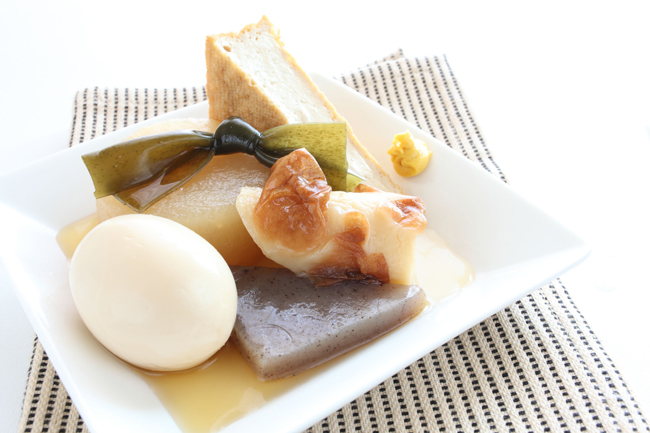
Kombu is a variety of Japanese seaweed used for making dashi and adding flavor to dishes. Kombu is used both to flavor the oden broth, and as a feature ingredient. You’ll be able to tell the kombu, dark green in color, and tied into decorative bow shapes. The stewing process makes the kombu soft and flavorful to eat.
Konnyaku and Shirataki

Konnyaku is obviously one of the most important oden ingredients, yet it is a mystery to foreign tasters. Known also as “Devil’s Tongue”, konnyaku has the consistency of firm jelly, and only a slight, almost fishy flavor. It’s actually made from a type of potato plant, the same family of potatoes as taro. The potato made into a flour then mixed with water and lime water.
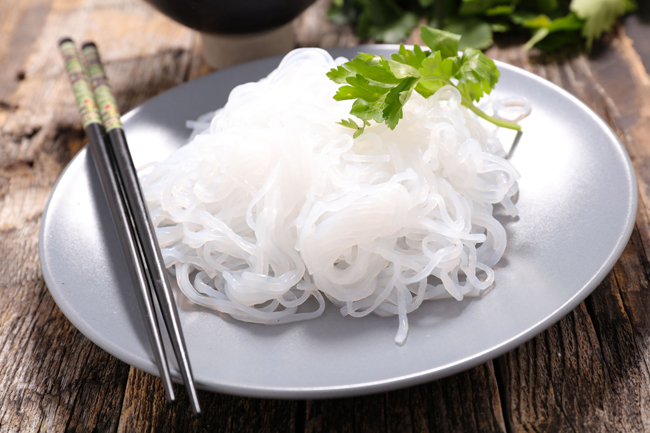
In oden, konnyaku can be found in triangular, slightly speckled grey wedges, or as noodles known as “shirataki”. Although konnyaku on its own doesn't have a lot of taste, it absorbs the rich flavor of the broth.
Tofu

is a cuisine where daikon radish, chikuwa, konnyaku, boiled eggs, and various other ingredients are put in and simmered in a dashi stock with soup flavored with soy sauce. The ingredients in an oden are called "odentane", and it may be eaten on its own, or eaten with Japanese mustard. The soup the "tane"differs depending on the region and restaurant.
Tofu comes in a variety of forms in oden. Ganmodoki are patties made of vegetables such as yamaimo, carrot, gobo and shiitake that have been blended into a paste with tofu and then deep-fried. Atsu-age is thick pieces of plain deep-fried tofu—the rich, golden casing and soft, creamy inside makes this a perfect oden ingredient. Mochi-iri kinchaku are little purse-shaped tofu pouches with a piece of mochi (Japanese glutinous rice cakes) inside (kinchaku meaning drawstring purse).
Boiled Eggs (Yude Tamago)

Soft and filling, boiled eggs are the perfect oden ingredient. You’ll notice the yude tamago in oden are chestnut-brown color from being steeped in stock for a long period of time. This process also gives the eggs a deep, deliciously savory, slightly salty and sweet flavor.
Hanpen

To first-time tasters, hanpen is another among many curious oden ingredients. It can be best described as a slightly fishy tasty marshmallow. Hanpen is a mixture of surimi, tororo (sticky grated yamaimo) and egg white. Because of its spongy, fluffy consistency, it is the perfect addition to Nikon dishes such as oden, as it absorbs the cooking liquid and grows deeper in flavor.
Cabbage Roll

This popular oden food features ground pork or beef mince, wrapped in a cabbage leaf and rolled up into a parcel. It may be secured with a shirataki noodles. The contrast of try savory mince with the sweet cooked cabbage, and overall juiciness is definitely one to sample.
Tsukune

Minced chicken shaped in into balls or pressed around skewers in a tubular shape is known as tsukune in Japan. At yakitori restaurants tsukune commonly appears on menus, grilled and topped with sauce. They can also be found on the menus of izakaya and bars as finger food.
Weiner

Weiners are a popular snack food in Japan, and make an appearance in pasta dishes, on bar food lists, and as an oden ingredient. They get extra juicy from their time soaking in the broth, and are easy to eat on the go.
Satsuma-age
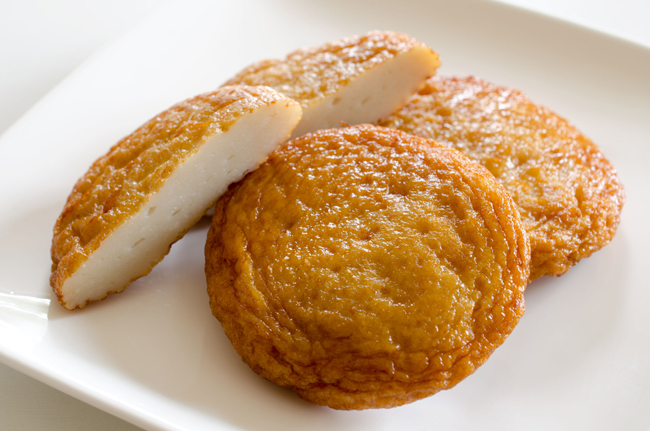
Originally from Kagoshima (“Satsuma” is the old name for Kagoshima City, and “age” means fried), satsuma-age are fried fishcakes. They are made by combining surimi and flour, often with some other kind of seafood or vegetables. The mixture is then shaped into patties about 1 cm thick and deep-fried.
Oden Is a Cheap and Tasty Meal, and the Perfect Accompaniment for Sake or Beer
Oden is a cheap, quick and nourishing meal, and is guaranteed to warm you up on a cold day. If you’re buying from a convenience store, simply order from the cashier staff by listing or pointing to the oden ingredients that you would like. Your oden will be presented to you in a container filled with delicious stock and accompanied by some condiments. With such variety on offer and at such an affordable price, look out for oden on your next trip to a convenience store, izakaya, festival, or browse Gurunavi’s listings of restaurants where you can eat oden in Japan.









